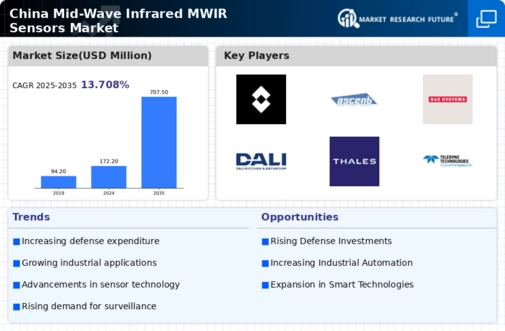Market Growth Projections
The Global China Mid-Wave Infrared MWIR Sensors Market Industry is projected to experience substantial growth over the coming years. The market is expected to reach a valuation of 1250 USD Million in 2024 and could potentially expand to 3500 USD Million by 2035. This growth trajectory suggests a compound annual growth rate (CAGR) of 9.81% from 2025 to 2035, indicating a robust demand for MWIR sensors across various applications. The increasing integration of these sensors in surveillance, industrial, and environmental monitoring applications underscores their growing importance in the global market.
Environmental Monitoring and Compliance
The Global China Mid-Wave Infrared MWIR Sensors Market Industry is also driven by the need for environmental monitoring and compliance. As regulatory frameworks become more stringent, industries are compelled to adopt technologies that facilitate emissions monitoring and environmental assessments. MWIR sensors are effective in detecting gas emissions and monitoring air quality, making them essential tools for compliance with environmental regulations. This growing focus on sustainability and environmental responsibility is likely to enhance the market's growth prospects, as organizations increasingly prioritize eco-friendly practices.
Increased Military and Defense Spending
The Global China Mid-Wave Infrared MWIR Sensors Market Industry is significantly influenced by increased military and defense spending. Governments are investing heavily in advanced surveillance and reconnaissance technologies to enhance national security. MWIR sensors are integral to military applications, providing critical capabilities for target detection and tracking. As defense budgets rise, particularly in Asia, the demand for these sensors is likely to grow. This trend aligns with the projected market value of 3500 USD Million by 2035, underscoring the importance of MWIR sensors in modern defense strategies.
Rising Adoption in Industrial Applications
The Global China Mid-Wave Infrared MWIR Sensors Market Industry is experiencing rising adoption in various industrial applications. Industries such as manufacturing and energy are increasingly utilizing MWIR sensors for process monitoring and quality control. These sensors enable non-contact temperature measurements, which are crucial for maintaining operational efficiency and safety. The growing emphasis on automation and smart manufacturing further propels this trend, as companies seek to integrate advanced technologies into their operations. This shift is expected to contribute to the overall market growth, reinforcing the relevance of MWIR sensors across diverse sectors.
Technological Advancements in Sensor Design
Technological advancements play a pivotal role in shaping the Global China Mid-Wave Infrared MWIR Sensors Market Industry. Innovations in sensor design, such as the development of smaller, more efficient sensors, enhance performance and broaden application areas. For example, the introduction of uncooled MWIR sensors has made these devices more accessible and cost-effective, thereby increasing their adoption in various sectors, including automotive and industrial applications. This trend is expected to contribute to a compound annual growth rate (CAGR) of 9.81% from 2025 to 2035, indicating a strong trajectory for the market as new technologies emerge.
Growing Demand for Advanced Surveillance Systems
The Global China Mid-Wave Infrared MWIR Sensors Market Industry is witnessing a surge in demand for advanced surveillance systems. This is largely driven by the increasing need for security in both public and private sectors. For instance, the integration of MWIR sensors in security cameras enhances the ability to detect intruders in low-light conditions, thereby improving safety measures. As of 2024, the market is valued at approximately 1250 USD Million, reflecting a robust interest in these technologies. The anticipated growth in urbanization and infrastructure development further supports this trend, suggesting that the market could expand significantly in the coming years.

















